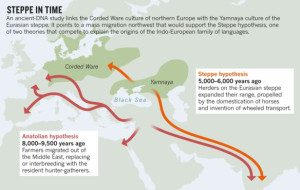I’m reading the new book, “Who we are and how we got here.”
It is about ancient DNA which is now being identified and studied. I have been interested in this topic since reading “The 10,000 year explosion,
which is about evolution and DNA but it is ten years old. One of the authors, Greg Cochran, has a blog, and has been reading and commenting on the Reich book.
The Denisovans were closer to the Neanderthals than they were to AMH, but not by much. Apparently modern humans split with the common ancestors of Denisovans and Neanderthals about 700,000 years ago, while Neanderthals and Denisovans separated not much later. Almost a trichotomy. Something similar happened when AMH spread into Eurasia: quite early, maybe 50,000 years ago, we split into eastern and western branches. Probably it’s all geography.
AMH is Anatomically Modern Humans.
Another interesting sidelight to this story of how ancient populations moved and replaced forbearers, is the role of Yersinia pestis, the plague organism.
Three pandemics have been attributed to plague in the last 1,500 years. Yersinia pestis caused the third, and its DNA was found in human remains from the second. The Antiqua biovar of Y. pestis may have caused the first pandemic; the other two biovars, Medievalis and Orientalis, may have caused the second and third pandemics, respectively. To test this hypothesis, we designed an original genotyping system based on intergenic spacer sequencing called multiple spacer typing (MST). We found that MST differentiated every biovar in a collection of 36 Y. pestis isolates representative of the three biovars. When MST was applied to dental pulp collected from remains of eight persons who likely died in the first and second pandemics, this system identified original sequences that matched those of Y. pestis Orientalis. These data indicate that Y. pestis caused cases of Justinian plague. The two historical plague pandemics were likely caused by Orientalis-like strains.
Now, the DNA of Y pestis has been found in remains of ancient skeletons, that suggests it might have been responsible for the replacement of ancient farmer by the nomadic Yamnaya people.
Late last fall, I reported that scientists had discovered a European ghost population. This group of people then referred to as the ANE, Ancient Northern Europeans, was a previously unknown population from the north that had mixed into the known European populations, the Hunter-Gatherers and the farmers from the Middle East, the Neolithic.
That discovery came as a result of the full genome sequencing of a few ancient specimens, including one from the Altai.
Recently, several papers have been published as a result of ongoing sequencing efforts of another 200 or so ancient specimens. As a result, scientists now believe that this ghost population has been identified as the Yamnaya and that they began a mass migration in different directions, including Europe, about 5,000 years ago. Along with their light skin and brown eyes, they brought along with them their gene(s) for lactose tolerance. So, if you have European heritage and are lactose tolerant, then maybe you can thank your Yamnaya ancestors.
They also had domesticated the horse and used wheeled carts, both huge innovations.

They may have been the ancient Scythians referred to by the Greeks. The preceding population of Europe may have been more easily replaced because they had been victims of Y pestis plague, making an even more ancient example of the power of this organism to change history.
Deep prehistory was always complicated: we just didn’t know much about it before. Ancient DNA analysis is the path forward.
I will add more as I finish the book.
God damn autocorrect !